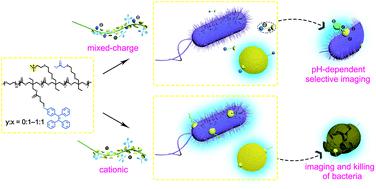当前位置:
X-MOL 学术
›
Biomater. Sci.
›
论文详情
Our official English website, www.x-mol.net, welcomes your
feedback! (Note: you will need to create a separate account there.)
Antibacterial AIE polycarbonates endowed with selective imaging capabilities by adjusting the electrostaticity of the mixed-charge backbone
Biomaterials Science ( IF 5.8 ) Pub Date : 2021-06-25 , DOI: 10.1039/d1bm00894c Junyong Zhang 1 , Wencheng Liang 1 , Lianlei Wen 1 , Zhimin Lu 1 , Yan Xiao 1 , Meidong Lang 1
Biomaterials Science ( IF 5.8 ) Pub Date : 2021-06-25 , DOI: 10.1039/d1bm00894c Junyong Zhang 1 , Wencheng Liang 1 , Lianlei Wen 1 , Zhimin Lu 1 , Yan Xiao 1 , Meidong Lang 1
Affiliation

|
Combining rapid microbial discrimination with antibacterial properties, multi-functional biomacromolecules allow the timely diagnosis and effective treatment of infectious diseases. Through a two-step approach involving organocatalytic ring-opening copolymerization and thiol–ene modification, aggregation-induced emission (AIE) polycarbonates decorated with tertiary amines were prepared. After being ionized using acetic acid, the obtained cationic AIE polycarbonate with excellent water solubility showed bacteria imaging capabilities and antibacterial activities toward both Gram-positive S. aureus and Gram-negative E. coli. It was indicated via scanning electron microscope images that the bactericidal mechanism involved membrane lysis, consistent with most cationic polymers. Through further co-grafting carboxyl and tertiary amine groups, mixed-charge AIE polycarbonates were obtained. The isoelectric points of such mixed-charge AIE polycarbonates could be simply tuned based on the grafting ratio of positive and negative moieties. Compared with the cationic AIE polycarbonate, mixed-charge AIE polycarbonates allowed the rapid and selective imaging of S. aureus, but not E. coli. The selectivity probably arose from the lower binding forces between the mixed-charge AIE polycarbonates and the low-negative-charge components of the E. coli surface. Therefore, these biodegradable polycarbonates, which integrated selective bacteria imaging and antibiotic abilities, potentially suggest a precision medicine approach for infectious diseases. The overall synthesis approach and mixed-charge AIE polycarbonates provide new references for the design and application of bio-related AIE polymers.
中文翻译:

通过调节混合电荷骨架的静电性,抗菌 AIE 聚碳酸酯具有选择性成像能力
结合快速微生物鉴别和抗菌特性,多功能生物大分子可以及时诊断和有效治疗传染病。通过涉及有机催化开环共聚和硫醇-烯改性的两步法,制备了叔胺装饰的聚集诱导发光 (AIE) 聚碳酸酯。使用乙酸电离后,获得的具有优异水溶性的阳离子 AIE 聚碳酸酯显示出细菌成像能力和对革兰氏阳性金黄色葡萄球菌和革兰氏阴性大肠杆菌的抗菌活性。它通过扫描电子显微镜图像表明杀菌机制涉及膜裂解,与大多数阳离子聚合物一致。通过进一步共接枝羧基和叔胺基团,得到混合电荷的 AIE 聚碳酸酯。这种混合电荷 AIE 聚碳酸酯的等电点可以根据正负部分的接枝率进行简单调整。与阳离子 AIE 聚碳酸酯相比,混合电荷 AIE 聚碳酸酯允许对金黄色葡萄球菌进行快速和选择性成像,但不能对大肠杆菌进行成像。选择性可能源于混合电荷 AIE 聚碳酸酯与大肠杆菌的低负电荷成分之间的结合力较低表面。因此,这些可生物降解的聚碳酸酯结合了选择性细菌成像和抗生素能力,有可能为传染病提供一种精准医学方法。整体合成方法和混合电荷AIE聚碳酸酯为生物相关AIE聚合物的设计和应用提供了新的参考。
更新日期:2021-06-28
中文翻译:

通过调节混合电荷骨架的静电性,抗菌 AIE 聚碳酸酯具有选择性成像能力
结合快速微生物鉴别和抗菌特性,多功能生物大分子可以及时诊断和有效治疗传染病。通过涉及有机催化开环共聚和硫醇-烯改性的两步法,制备了叔胺装饰的聚集诱导发光 (AIE) 聚碳酸酯。使用乙酸电离后,获得的具有优异水溶性的阳离子 AIE 聚碳酸酯显示出细菌成像能力和对革兰氏阳性金黄色葡萄球菌和革兰氏阴性大肠杆菌的抗菌活性。它通过扫描电子显微镜图像表明杀菌机制涉及膜裂解,与大多数阳离子聚合物一致。通过进一步共接枝羧基和叔胺基团,得到混合电荷的 AIE 聚碳酸酯。这种混合电荷 AIE 聚碳酸酯的等电点可以根据正负部分的接枝率进行简单调整。与阳离子 AIE 聚碳酸酯相比,混合电荷 AIE 聚碳酸酯允许对金黄色葡萄球菌进行快速和选择性成像,但不能对大肠杆菌进行成像。选择性可能源于混合电荷 AIE 聚碳酸酯与大肠杆菌的低负电荷成分之间的结合力较低表面。因此,这些可生物降解的聚碳酸酯结合了选择性细菌成像和抗生素能力,有可能为传染病提供一种精准医学方法。整体合成方法和混合电荷AIE聚碳酸酯为生物相关AIE聚合物的设计和应用提供了新的参考。

































 京公网安备 11010802027423号
京公网安备 11010802027423号